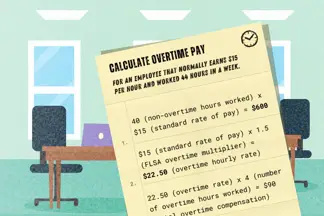How to Calculate Overtime? A Complete Guide to Calculating Overtime
Comprehending the FLSA, which requires nonexempt employees to be paid 1.5 times their regular rates for hours over 40 in a workweek, is the initial step in calculating overtime pay.
The FLSA, as well as state and local wage and hour laws, must all be complied with by businesses, which makes things even more difficult. Employers are required to apply the overtime pay rate that benefits the employee where these regulations contradict. So, let's dive into "How to Calculate Overtime" with Aniday.

What is Overtime Pay?
Overtime incentives, commonly known as time and a half, reward employees for working beyond their regular hours, providing extra compensation for their added time and effort. Irrespective of an individual's location, profession, or employment contract terms, working more hours naturally translates into higher earnings.
How Does Overtime Work?
The concept of overtime becomes relevant when employees exceed a defined threshold of work hours within a specific timeframe. Local labor regulations, employment contracts, or industry norms may all influence this time frame. The Fair Labor Standards Act (FLSA) in the United States sets the global standard, requiring eligible employees to be paid 1.5 times their regular hourly wage for hours exceeding 40 in a workweek.
Overtime takes on different forms – weekly, daily, consecutive days, or public holidays – each with distinct calculations and consequences.
Overtime can be structured in different ways, such as:
-
Weekly overtime: Calculated based on the total hours worked in a workweek.
-
Daily overtime: Calculated based on hours worked in a single workday.
-
Overtime for consecutive days: Applied when an employee works for a specific number of days consecutively.
-
Overtime on public holidays: Some labor laws require additional compensation for working on holidays.
Calculating Overtime Pay for Hourly Workers

Calculating overtime pay for hourly workers is quite simple. To calculate their overtime earnings, follow these steps:
Step 1: Determine the Overtime Rate
Find out the overtime rate specified by local labor laws or employment agreements. In many cases, this is 1.5 times the regular hourly wage.
Step 2: Identify the Work Period
Determine the work period for which overtime is calculated. Typically, this is a workweek but can vary based on the employment agreement.
Step 3: Calculate the Total Hours Worked
Add up all the hours worked by the employee within the designated work period. Add up both standard work hours and any extra hours.
Step 4: Count the hours worked in overtime
Deduct the legal limit from the total to determine the number of overtime hours worked if the total number of hours worked during the work period exceeds the legal limit (for example, 40 hours in the US).
Step 5: Determine Overtime Pay
To determine the overtime pay, multiply the number of overtime hours by the applicable overtime rate.
Formula: Overtime Pay = Overtime Hours × Overtime Rate
Example: A worker earning $12 per hour with a 1.5x overtime rate works 45 hours per week. The calculation could be as follows:
-
Total Hours Worked: 45 hours
-
Calculate overtime hours: 45 hours - 40 hours = 5 hours.
-
Overtime Pay: 5 hours × $12/hour × 1.5 = $90
Overtime Pay Calculation for Nonexempt Employees Earning a Salary

Normally, a pay is intended to cover nonexempt workers' normal, anticipated hours of work throughout a typical work week. Simply divide the employee's weekly wage by the total number of hours worked to determine their normal rate of pay under federal law.
Each place has unique methods to determine compensation for employees ineligible for tax-exempt salaries, so employers must diligently research and comply with local laws in their work and residence area.
Example:
Let's examine an illustration to demonstrate how the determination of overtime pay for a nonexempt worker earning a salary is done. Assume that this individual receives a fixed weekly salary of $1,200 for a 40-hour workweek. To meet a vital deadline, they do, however, labor an additional two hours one week. The following formula can be used to calculate the employee's total pay for the workweek, including the overtime premium:
-
Regular Rate of Pay: Divide the weekly salary by the standard hours worked.
Regular rate of pay: $1,200 / 40 hours = $30
-
Overtime Premium Rate: Determine the overtime premium rate by multiplying the regular rate of pay by 1.5 (as per federal law).
$30 x 1.5 = $45 overtime premium rate of pay
-
Overtime Premium Pay: Calculate the additional pay for the overtime hours worked.
Overtime premium pay: $45 x 2 overtime hours = $90
-
Total Pay Due: Sum the regular salary and the overtime premium pay to determine the employee's total pay for the workweek.
$1,200 (salary) + $90 (overtime premium pay) = $1,290 total pay due
Calculating Overtime Pay for Non-Hourly Compensation
Certain employees receive compensation beyond hourly or salaried wages, involving various forms of compensation, including piece-rate work, non-discretionary bonuses, and commission payments. The methods for calculating overtime in these cases may differ.
For piece-rate work, the approach involves dividing the piece rate earnings by hours worked to find the regular rate of pay, and then applying the overtime premium rate to compute overtime pay. However, certain states may have unique regulations for piece-rate workers.
When it comes to non-discretionary bonuses and commissions, the Fair Labor Standards Act mandates that these should be incorporated into the regular rate of pay, with specific calculation methods for different bonus payment frequencies. State laws may also introduce additional variations for flat-sum bonuses.
Overtime Rules and Regulations
The FLSA requires nonexempt employees who clock in for more than 40 hours per week to be subject to a standard overtime calculation that multiplies their regular rate of pay by 1.5. It's critical to realize that different states may have very different overtime regulations.
In California, if employees work beyond specified daily hours, they qualify for 1.5x overtime pay and, in some cases, double their standard wage, known as "double time."
Conclusion
Both employers and employees must be aware of how to calculate overtime compensation in order to guarantee that employees are adequately reimbursed for their extra efforts. By following the instructions offered in this thorough tutorial from Aniday, you can negotiate the difficult world of overtime pay with assurance and transparency, ensuring that people who spend their time and energy beyond the regular work schedule are fairly compensated.
Aniday's HR Services
Headhunting Service
Find and recruit quality candidates in just 1 week! Supported by 40,000 experienced headhunters in IT, Finance, Marketing… capable of recruiting in any region.
Headhunting Service ➔Employer of Record (EOR) Service
On behalf of your business, we recruit employees and handle payroll without the need to establish a company in markets such as Vietnam, Singapore, Malaysia, India, Indonesia…
Employer of Record (EOR) Service ➔